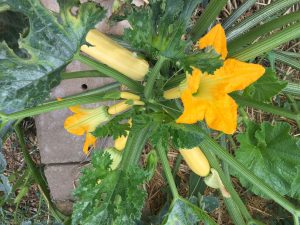National Pollinator Week was June 17-23. Whether you grow a lone tomato plant or an extensive garden, most vegetables and fruit require pollination to produce food.
Flowering Crops Are Usually Insect-Pollinated. Pollen must get from the male anther on one flower to the female stigma on another flower. This is true of melons, squash, cucumbers, pumpkins and orchard fruits including apples, apricots, and pears. Bees literally carry the big load while assorted flies, wasps, some beetles and hummingbirds pitch in.
Lacking insect pollinators, you can become the pollinator for squashes and pumpkins. Using a soft brush, Q-tip or a feather, gently brush the yellow pollen from freshly opened male flowers (the ones with the long stem) on to the female flowers (with a short stem and miniature fruit at the base of flower).
Tomatoes, Peppers, And Eggplants Are (Mostly) Self-Pollinated. With these plants, pollen must move from the male to female parts of the same flower or to another flower on the same plant.
However, the male part of the flowers, the anther, is fussy about releasing its precious pollen. Tomato pollination is more likely on sunny days with a gentle wind. Blossoms may drop with night temperatures below 55 degrees or high daytime temperatures. To encourage pollen release, try gently shaking your tomato and other self-pollinated plants (when they’re blooming of course).
Corn and Other Grains Are Wind-Pollinated. Relying on air currents, the pollen is carried from flowering parts on the silks of one plant to that of another. For a good crop, plant corn in blocks rather than a few skinny rows. This principle is true of other grains as well.
Boost Your Garden’s Total Production by inviting more bees. Both native and honeybees are declining, but we can help all bees prosper. Welcome them by skipping pesticides altogether and in time your garden will enjoy a balance between insects and other critters. Leave some unmulched, untilled open ground since native bees often live in burrows.
Plant flowers that nourish bees throughout the year. Pollinators need old-fashioned, simple flowers so they can reach the pollen and nectar in the blossom’s center. California native plants have been shown to be especially helpful. Grow flowering annuals—zinnias, alyssum and borage—among your veggies. Learn more about helping pollinators at https://urbanbeelab.org/ and https://xerces.org/ From the Xerces Society order their books, “Attracting Native Pollinators” and “100 Plants to Feed Bees.”
Vera Strader is a University of California Cooperative Extension Honorary Master Gardener of Tuolumne County.

